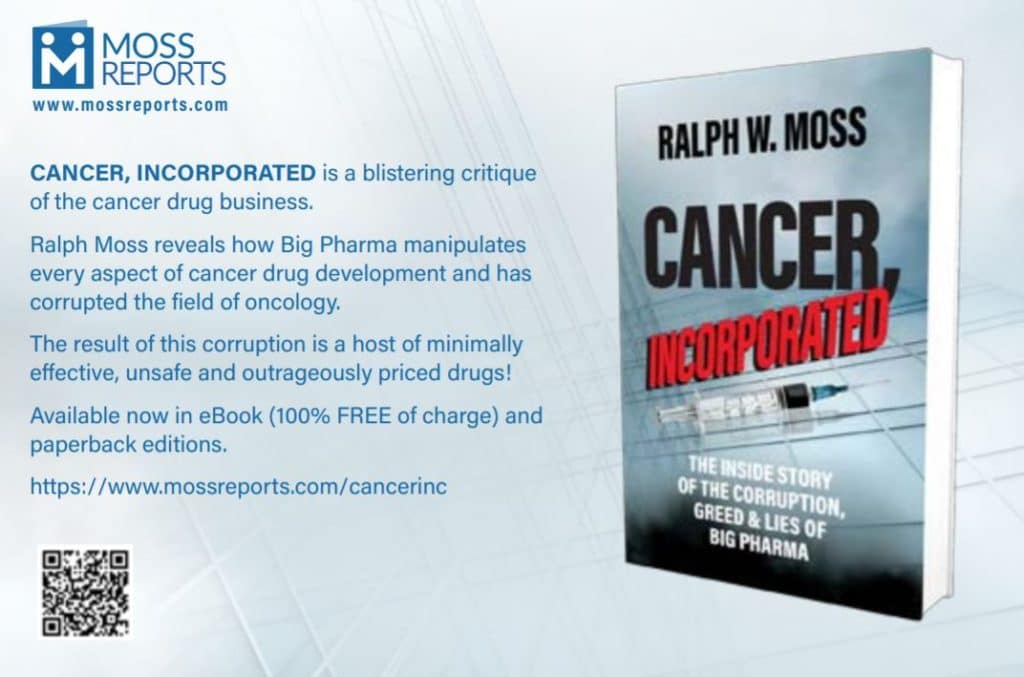By Ralph Moss, PhD
The medical establishment, epitomized by the US Food and Drug Administration (FDA), is notoriously slow at adopting new methods, however effective they might be. For example, immunotherapy, in the form of Coley’s toxins, was demonstrated as effective in ten cases of advanced cancer as early as the early 1890s (Coley 1893). But the FDA did not recognize any form of immunotherapy for cancer until 1990, nearly a century (Tontonoz 2020). Similarly, photodynamic therapy (PDT) was discovered in 1900 (Raab) and was used to treat cancer at Roswell Park Cancer Institute starting in 1974. But the FDA did not approve it until more than two decades later, in 1995.
But the granddaddy of medical delays has to be the cryoablation of malignant tissues. The application of ultra-cold to destroy cancer was demonstrated at the great Crystal Palace Exhibition, which took place in Hyde Park, London, from May to October of 1851.

A surgeon, James Arnott, MD (1797-1883), had been using cold instruments to treat cancer since 1845. He won a medal for his demonstration of cryoablation at the Crystal Palace Exhibition. Tens of thousands of people, including Queen Victoria, Charles Dickens, and Charles Darwin, attended this exhibit, and so cryoablation was hardly a secret. It was publicly available a decade before the American Civil War! (Arnott 1861; Cooper and Dawber, 2001)
For the treatment of cancer, Arnott used a salt and ice solution to attain temperatures of -18º to -24º C (i.e., – 0.4º to – 11º F), and to freeze cancers of the breast and cervix. This resulted in decreased tumor size, a reduction in drainage, and the amelioration of pain. Arnott wrote these prophetic words: “Congelation [i.e., freezing] arresting the accompanying inflammation, and destroying the vitality of the cancer cell, is not only calculated to prolong life for a great period but may, not improbably, in the early stage of the disease, exert a curative action.”
Nonetheless, this technique disappeared for another century and only started up again in the 1960s, when two New York urologists, Ward A. Soanes, MD, and Maurice J. Gonder, MD, developed the first modern apparatus for the transurethral freezing of the prostate gland. In 1966, the Journal of the American Medical Association (JAMA) reported:
Controlled destruction of tissue by super-freezing has been effective in relieving benign and malignant prostatic obstructions, members of the American Urological Association were told at their annual meeting. Ward A. Soanes, MD, said cryosurgical destruction of prostatic tissue is a further application of pioneer work—primarily in brain surgery—done by others with extreme-cold techniques. (Anon. 1966)
Soames and Gonder used the technique on at least 150 patients “with no mortality and minimal morbidity.” It was the beginning of the modern era in cryoablation. Since then, progress has been slow but steady.
But the current version of cryoablation “has almost nothing in common with those versions established in the 1960s and 1970s and further developed in the 1980s and 1990s. The present version,” Dr. Witzsch wrote in 2009, “is minimally invasive and has a high efficacy for treatment of high-risk carcinomas and failure of other therapeutic modalities” (Witzsch 2009).
So when did the FDA finally approve cryoablation for cancer? Technically, never, since, as a surgical procedure, it was not subject to regulation by the FDA. But a number of cryoablation systems and cryoprobes have what is called general surgical FDA 510(k) marketing clearance. Examples of cryoablation devices that specifically mention the treatment of prostate cancer in their marketing clearance are two Endocare® Inc. devices, Cryocare CS® and Cryocare CN2® systems, and two Galil Medical devices, Visual-ICE® Cryoablation System and IceRod® CX Cryoablation Needle. Endocare received the first FDA approval in 2006, and the others gained approval in the intervening years. In sum, it took over 150 years from the time that Arnott first demonstrated cryoablation for cancer to the British public to the time it was finally recognized by the FDA and by most insurance plans.
Cryoablation (inaccurately called cryosurgery) is a technique to destroy diseased tissue by applying probes at extremely low temperatures. It is not “surgery” in the ordinary sense, in that no scalpels or other cutting instruments are employed. “Cryo” is increasingly used to treat the following kinds of cancer:
- Prostate cancer—either focally, as a so-called “male lumpectomy,” or to destroy the entire gland,
- Select cases of breast cancer,
- Liver cancer (HCC) and liver metastases,
- Retinoblastoma (a childhood cancer affecting the retina of the eye),
- Early-stage basal and squamous cell carcinomas of the skin,
- Precancerous actinic keratosis (skin),
- Precancerous cervical intraepithelial neoplasia (CIN).
It is also used experimentally in tumors of the bone, AIDS-related Kaposi sarcoma, colon, and renal cell carcinoma. It can be used as a stand-alone treatment or in combination with other treatments, such as immunotherapy.
“Cryo” is a very promising and less toxic way of destroying localized tumors or ablating an entire area (such as the entire prostate gland). Not surprisingly, cycles of rapidly freezing and thawing cells bring about tissue destruction. Because of the steady improvement in design and the successful marketing and FDA approval of ultrasound guidance instruments, “cryo” is now a real option for many patients. As word spreads that “cryo” is less damaging than some competing methods, its popularity grows. According to Dr. Bryan J. Donnelly of Calgary: “With longer-term follow-up, the trend favors cryoablation. Significantly fewer positive biopsies were documented after cryoablation than after radiotherapy” (Donnelly 2010, John 2012).
Cryoablation of the prostate gland today is an outpatient procedure, conducted in a relatively brief session under light anesthesia. It is not particularly painful, but it does require the insertion of a catheter (a drainage tube inserted into the bladder) to prevent urinary retention. This is removed after a few days, provided that the patient can urinate on his own.
Third-Generation Cryo
So-called “third-generation” technical refinements include (a) improved 3-Tesla MRI and ultrasound localization of the tumor; (b) the routine use of urethral warmers to prevent collateral damage; and (c) small-gauge delivery systems. The technique uses a fine hollow probe, guided by ultrasound, to penetrate the tumor and introduce liquid nitrogen or argon. This creates a super-cooled area within the tumor, resulting in the ablation of the cancer while leaving healthy tissue unharmed (Hubosk 2007).
Also, probe design and energy sources evolved rapidly over the past two decades. For example, patients with localized liver metastases, which are not accessible to surgery, may still be cryotherapy candidates. The technique is also useful as an adjunct to chemotherapy since chemotherapy, even hepatic arterial infusion (HAI) may be unable to completely destroy tumors or extend life (Bhardwaj 2012).
“Cryo” for liver metastases used to be carried out via laparotomy (a surgical incision made in the wall of the abdomen), but with the increased sensitivity of MRI and ultrasound techniques, percutaneous (i.e., through the intact skin) approaches are now safe and accurate.
There are 500+ PubMed-indexed articles on the use of cryosurgery for liver cancer (HCC) alone. But there is still a lack of knowledge on how well cryoablation stacks up against competing methods. In 2009, British liver surgeons wrote: “Perhaps the time has come, therefore, for prospective large-scale randomized control trials to take place comparing ablation modalities to each other and surgical resection” (PubMed ID 19554370). This has been an urgent need for many years (Bhardwaj 2009), but according to www.clinicaltrials.gov such a test has never been performed.
Cryoablation for Breast Cancer
Many breast cancer patients are looking for an alternative to surgery to remove their tumors. Cryoablation has the advantage of a painless, bloodless way of destroying a tumor quickly without the invasiveness of surgery. Instead of having a lumpectomy or mastectomy to remove a breast tumor, doctors insert a thin needle-like device into the mass and then produce a blast of extreme coldness to destroy the malignant tumor. There is no need for sedation or hospitalization, and no pain or scarring. At a growing number of US medical centers, this is considered a viable alternative to surgery for early-stage breast cancers.
An American College of Surgeons Oncology Group carried out a clinical trial affirming this (PubMed ID 27221361). It involved 87 breast cancer patients (with a total of 92 tumors) treated at 19 medical centers around the US. The patients in question all had invasive ductal carcinomas of 2 centimeters or smaller, which could be visualized on ultrasound. Magnetic resonance scans MRIs) were also performed to look at the tumors. After the simple procedure was performed, tissue from the former tumors was examined to see if all the malignant cells were gone. And in fact no remaining cancer was found in 80 out of 92 of the targeted tumors. There was also 100% ablation of tumors smaller than one centimeter in diameter (Simmons 2016).
After a while, the patients’ body reabsorbed the killed cancer cells and no traces of it were found on mammograms or other imaging scans. To quote from a 2016 New York-Presbyterian/Weill Cornell Medical Center media release:
“It’s a huge advance for women—I think this could be the wave of the future,” said the study’s lead author, Rache M. Simmons, MD, chief of breast surgery at New York-Presbyterian/Weill Cornell Medical Center. “The beauty of it is it takes less than half an hour, then the patient goes home with a Band-Aid on the tiny incision. There’s no recovery time.” The procedure can be performed in an outpatient setting with only a topical anesthetic applied to the skin.
US News & World Report ranks New-York Presbyterian as the #1 hospital in New York. It is also ranked #4 of all hospitals in the US. So, this ringing endorsement of cryoablation means a lot. We’ll have to see, however, if it can finally put an end to a century and a half of foot-dragging on this topic by conservatives within the medical profession.
NOTE: One should check clinicaltrials.gov for clinical trials employing cryoablation for a particular type of cancer. At the time of writing, using the search terms ‘cryoablation’ and ‘cancer’ brought up several dozen trials recruiting patients to treat various cancer types.
References
Anon. Cryosurgery On Prostate Reported. JAMA. 1966;196(13):29.
Arnott, J. On the Treatment of Cancer by the Regulated Application of an Anaesthetic Temperature. London: Churchill, 1851.
Bhardwaj N, et al. Liver ablation techniques: a review. Surg Endosc. 2010;24:254-265.
Coley WB. The treatment of malignant tumors by repeated inoculations of erysipelas. With a report of ten original cases. 1893. Clin Orthop Relat Res. 1991 Jan;(262):3-11. PMID: 1984929.
Cooper, SM, and R P R Dawber. The History of Cryosurgery. Journal of the Royal Society of Medicine. April 2001;94 (4): 196–201.
Donnelly BJ, et al. A Randomized Trial of External Beam Radiotherapy versus Cryoablation in Patients with Localized Prostate Cancer. Cancer. January 25, 2010;116(2): 323–30
Gangi A, et al. Percutaneous MR-guided cryoablation of prostate cancer: initial experience. Eur Radiol. 2012;22(8):1829–1835.
Hubosky SG, et al. Single-center experience with third-generation cryosurgery for management of organ-confined prostate cancer: critical evaluation of short-term outcomes, complications, and patient quality of life. J Endourol. 2007;21:1521-1531).
John BJ, Davidson BR. Treatment options for unresectable neuroendocrine liver metastases. Expert Rev Gastroenterol Hepatol. 2012;6(3):357–369.
Lam S, et al. A randomized comparative study of the safety and efficacy of photodynamic therapy using Photofrin II combined with palliative radiotherapy versus palliative radiotherapy alone in patients with inoperable obstructive non-small cell bronchogenic carcinoma. Photochem Photobiol. 1987 Nov;46(5):893-7.
Liu, Yi Yang, and Po Hui Chiang. Comparisons of Oncological and Functional Outcomes Between Primary Whole-Gland Cryoablation and High-Intensity Focused Ultrasound for Localized Prostate Cancer. Annals of Surgical Oncology. January 2016; 23(1): 328–34.
Raab O. Uber die Wirkung, fluoreszierender Stoffe auf infusorien. Z. Biol. 1900;39:524–546.
Tontonozk M. The ABCs of BCG: Oldest Approved Immunotherapy Gets New Explanation, July 17, 2020. https://www.mskcc.org/news/oldest-approved-immunotherapy-gets-new-explanation
Witzsch UKF, Becht E. [Cryoablation of localized prostate cancer: Current state.]. Urologe A. 2009;48:719-728.
FURTHER READING…














